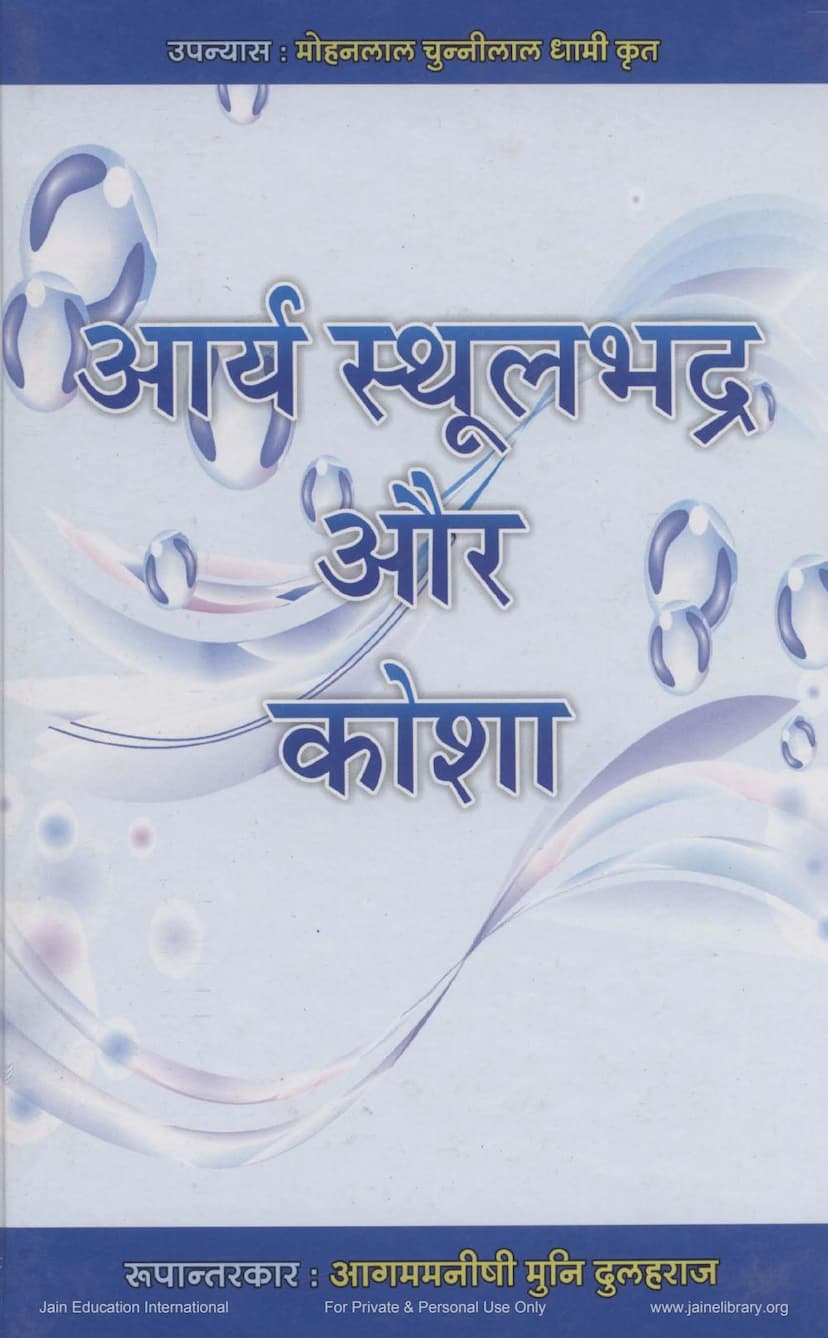Arya Sthulabhadra Aur Kosha
Added to library: September 1, 2025

Summary
Here is a comprehensive summary of the Jain text "Arya Sthulabhadra aur Kosha" by Mohanlal C Dhami, adapted by Muni Dulahraj:
The book "Arya Sthulabhadra aur Kosha" is a novel that delves into the life and interactions of Arya Sthulabhadra and Kosha. It is presented as a Hindi adaptation of a Gujarati novel by Mohanlal Chunnilal Dhami, with Muni Dulahraj being the adapter. Published by Jain Vishva Bharati, the book aims to make significant Jain historical and cultural narratives accessible to a wider audience, particularly the younger generation.
The novel is rich in its depiction of ancient Indian society, particularly the city of Pataliputra during the time of the Nand dynasty. It paints a vivid picture of the opulent lifestyle of the era, the cultural milieu, and the prominent figures who shaped it.
Key Themes and Narrative Elements:
- Kosha's Character: Kosha is portrayed as the beautiful and accomplished daughter of Sunanda, the royal dancer of Magadha. She is described as a paragon of beauty, youth, and artistic talent, skilled in music, dance, poetry, and other arts. Her life is deeply intertwined with the pursuit of perfection in her artistic endeavors, particularly dance. She is shown undergoing rigorous training under the guidance of the renowned music and dance guru, Acharya Kumardev.
- Arya Sthulabhadra's Character: Arya Sthulabhadra is depicted as the eldest son of the influential minister Shakadala. Despite his noble lineage and access to worldly pleasures, Sthulabhadra is shown to be detached and inclined towards spiritual pursuits. His inherent virtue and philosophical outlook set him apart. His initial interaction with Kosha is through her captivating Veena music, which deeply affects him.
- The Encounter and Attraction: The story begins with a chance encounter where Sthulabhadra's Veena music captivates Kosha. This initial musical exchange sparks an attraction between them, setting the stage for their complex relationship. Kosha, initially drawn to Sthulabhadra's artistic prowess, finds herself increasingly intrigued by his detached demeanor and profound nature.
- Sthulabhadra's Renunciation and Kosha's Pursuit: The novel highlights Sthulabhadra's spiritual inclination and his eventual renunciation of worldly life to follow the path of Jainism. Kosha, deeply affected by Sthulabhadra's asceticism and spiritual aura, embarks on a mission to win him over. She uses all her artistic talents, beauty, and allure to break his resolve, but Sthulabhadra remains steadfast in his spiritual path, even when in close proximity to Kosha for extended periods. This emphasizes Sthulabhadra's immense self-control and his victory over worldly desires.
- The Grand City of Pataliputra: Pataliputra is vividly described as a center of art, culture, knowledge, and prosperity. The text mentions various influential figures like Chanakya, Mahakavi Vararuchi, and King Dhanananda, enriching the historical backdrop of the narrative. The vibrant descriptions of the city, its palaces, gardens, and the river Ganga contribute to the immersive experience.
- Societal and Philosophical Themes: The novel explores themes of renunciation versus worldly attachment, the power of art and beauty, the importance of spiritual discipline, and the societal expectations of the time. It showcases the profound philosophical underpinnings of Jainism through Sthulabhadra's steadfastness.
- Kosha's Transformation and Aspirations: Kosha's journey is not just about pursuing Sthulabhadra; it's also about her own evolution. She becomes a renowned dancer and dancer, showcasing exceptional talent. She also grapples with her mother Sunanda's decision to renounce worldly life, and the pressure to become the next royal dancer. Her interactions with Sthulabhadra, even from a distance, influence her path. Ultimately, after Sthulabhadra's renunciation and her own experiences, Kosha herself embarks on a spiritual journey, seeking liberation.
- The Role of Other Characters: Various characters like Chanakya, Vararuchi, and Sunanda play significant roles in shaping the narrative and providing context. Chanakya's strategic advice to Sthulabhadra's father, Shakadala, regarding Sthulabhadra's detachment, highlights the societal concerns around such detachment. Sunanda's own spiritual inclinations and her departure influence Kosha's life path.
- The Struggle Between Worldly and Spiritual Paths: A central conflict lies in the clash between the worldly allure represented by Kosha's beauty and art, and the spiritual path embodied by Arya Sthulabhadra. The narrative highlights the internal struggle within characters, particularly Kosha, as she navigates her desires and her admiration for Sthulabhadra's path.
- The Culmination of the Narrative: The novel portrays Sthulabhadra's eventual decision to become a Jain ascetic, a path Kosha, despite her deep admiration and efforts, cannot sway. This renunciation marks a turning point, and Kosha herself eventually moves towards a spiritual life, influenced by the principles of Jainism.
In essence, "Arya Sthulabhadra aur Kosha" is a well-researched and engaging novel that blends historical accuracy with compelling storytelling. It aims to inspire readers by showcasing the strength of character, the pursuit of spiritual ideals, and the profound cultural heritage of Jainism. The narrative skillfully depicts the complexities of human emotions, societal pressures, and the ultimate triumph of inner conviction over external allure, as exemplified by the lives of Arya Sthulabhadra and Kosha.